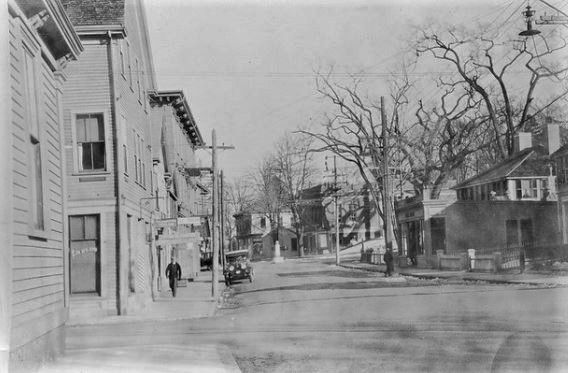Hingham Municipal Lighting Plant, MA, 1927-1930, Utility Pole Lines Through Center
By Joe Maurath, Jr.; posted July 19, 2020
View Original: Click to zoom, then click to magnify (568 x 373) 83KB

|
The "downtown" area of this quaint historic seacoast community consists only of two or three blocks as it has for well over a century. Shown are some electric utility lines along one of the town's business district streets (South Street at Central, looking East). Like the other lines throughout Hingham, they were always kept in excellent condition and never publicly condemned as an eyesore (as far as I know). The two incandescent street lights were mounted exactly where arc lights once were (up until 1912). These lines were placed underground in the late 1940s as part of an improvement project the town and its electric utility undertook. A few photos of this will follow at a later date. The street railway company abandoned its lines throughout town by 1926 and the town "inherited" the poles, wiring, etc. In order to aesthetically maintain the community's streets, the town light plant eventually removed all of its property [id=599523011]. The utility's commissioners stated: "It has always been the policy of the Municipal Light Board to maintain the plant in first-class condition, and the present board believes there are few Municipal Light Plants where the money expended by taxpayers show greater actual cash value at the present moment. It also is the policy of the present Board to extend and improve the service wherever conditions justify, and within these conditions met, to reduce the price of current as fast as it is safe to do so." Further improvements during the late 1920s related to major reconstruction work undertook by the state highway department along a mile-long stretch of very busy roadway leading to Nantasket Beach in Hull, MA (right over the town border). It was necessary to relocate this pole line to the other side of road, the old line can be seen here: [id=598483777] (Rockland Street looking east). Since this area is subject to strong easterly winds, coastal storms and flooding, most of the new poles were set far back from the roadway. The line-building choices at the time must have been pretty good since most of the late 1920s-era poles were still standing through the 1970s and 1980s; the old ones generally were replaced because new spacer-cable wire was installed. |